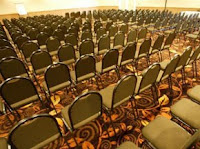Ballroom Learning and Large Groups: Using Socratic Questioning
— Socrates (Quoted in Xenophon’s “Economics”)
I am sitting in a hotel ballroom with 140 people at a conference titled, “Capacity Development Strategies: Let the evidence speak” and the level of some of the participants has dictated a certain room layout and format – we have a head table with four speakers and 140+ people sitting shoulder to shoulder behind tables in the room. There are a number of international speakers sharing their knowledge about issues such as: Capacities for local development, Capacity development at work, etc. When the speakers are finished with their interventions, they stop, and the chair asks for questions from the audience. A couple of questions are asked and answered. They come from different people and are unconnected. The Rapporteur works to identify threads and lessons from the session. The purpose of the meeting is to draw some new insights from the speakers and the group about these critical issues, and to exchange knowledge so we can all learn.
If learning is the goal, and this formal room layout is a given, how might we best work with this format for optimal exchange?
One possibility might be to structure the Q&A session differently. How different might the post-speaker discussion be, if the speaker asked the audience the questions instead? Would it be more focused? Would it help people in the audience connect what the speaker said with their own experience and help them share their opinion? Would it focus the discussions and shed some new light on the subject for everyone with more contributions from the floor?
We use the Socratic method in workshops to lead people into discussions on issues that help them explore what they already know and build on it with the experience of their peers. Could this method work in this ballroom as well? And if we were using this ballroom for what it was built for (dancing, celebration, conversation) would we be interacting and sharing more?




Leave a Reply
Want to join the discussion?Feel free to contribute!